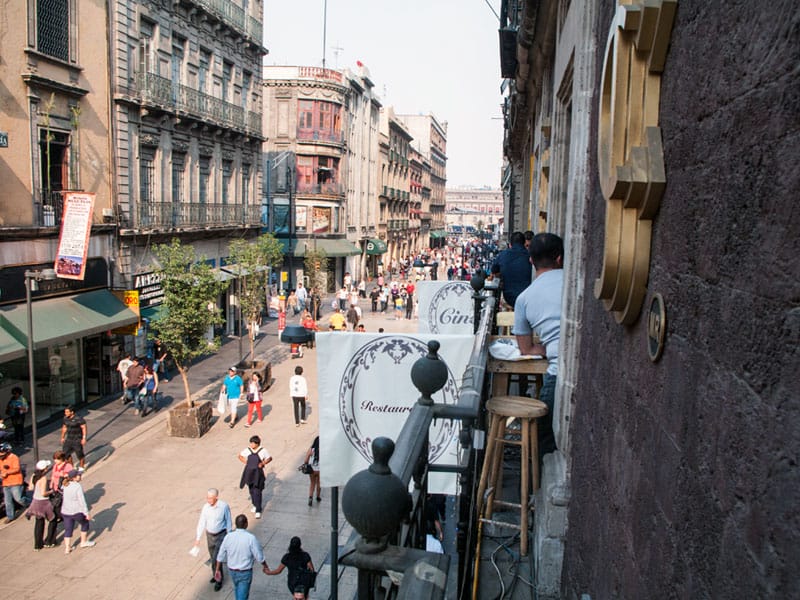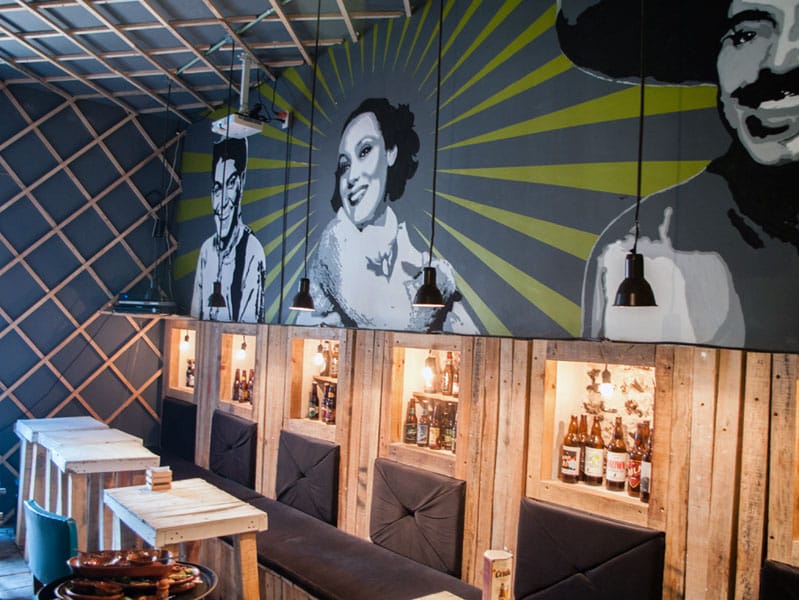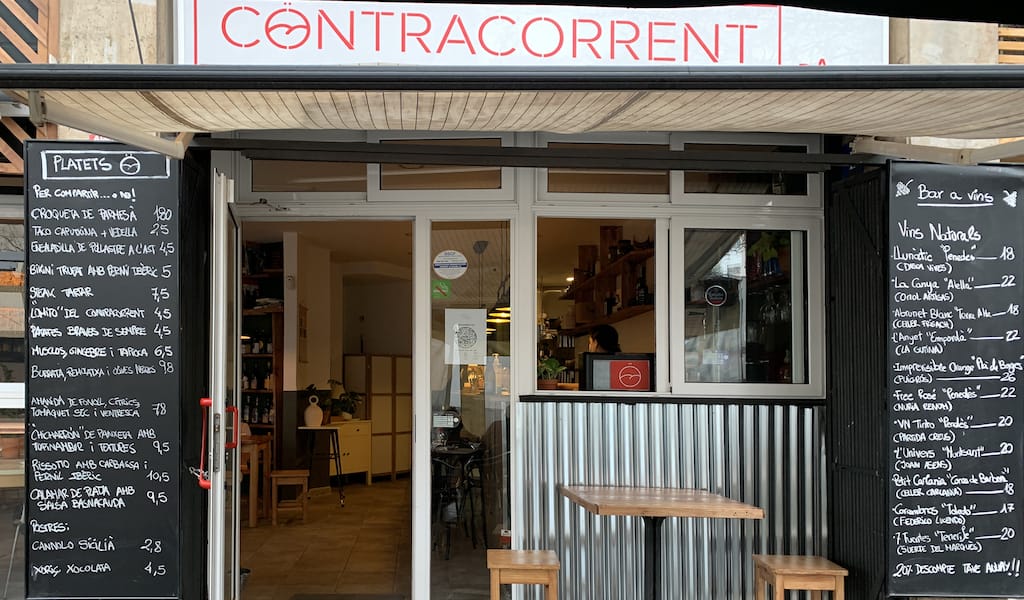Update: This spot is sadly no longer open.
Until not long ago, Francisco I. Madero was a typical – and rather uninviting – street in Mexico City’s Centro Histórico, uneven and full of potholes, with narrow sidewalks. The avenue was constantly clogged with car traffic trying to make its way to the Zócalo plaza in the center of the neighborhood. In short, it was a mess.
Then, as part of Mexico City’s push to revitalize the area, Madero was closed to traffic and rebuilt as a pedestrian-only thoroughfare. The street and sidewalks were leveled, landscaping and benches went in, and historic buildings were repaired and renovated. Foot traffic exploded and it is now the busiest pedestrian street in the city. As a result, existing businesses have thrived, while many new ones have opened up, including several restaurants, which have helped transform the area’s previously dismal culinary scene. One of the best examples of this revitalization is Hilaria Gastrobar, a bar and eatery on Madero that opened just four months ago. Although we went expecting low-quality tourist-oriented fare, we were pleasantly surprised to discover something a lot more special instead.

Hilaria is the brainchild of Adrián Gómez and his business partners, who, wanting to be a part of the neighborhood’s conversion into a hip, urban area, found a centuries-old building halfway down Madero to be the perfect location. Like many restaurants in the Centro Histórico, Hilaria has someone on the street calling out to pedestrians and trying to entice them to come inside for a bite. In this case, a young girl standing outside the venue led us (as if into a secret speakeasy) through a jewelry shop and then up an elevator to the second floor, where she pointed out the entrance to the restaurant.
The venue makes an impression right from the start. The décor evokes an old woodworking shop with modern touches that’s been lovingly converted into a restaurant. The floors are made from reclaimed lumber from a local construction site; as we walked, the boards creaked and gave as if we were on an old ship being tossed over rough seas. The tables are also made from reclaimed lumber, while the ancient plaster and volcanic rock walls give the entire place a very rustic feel. Three separate dining areas – including one in which there are regular showings of movies – provide plenty of seating. We opted to eat in the third dining section, which was located directly in the kitchen. Indeed, the only separation between our seats and the cooking area itself was a wall of clear glass, through which we could see all the kitchen action.
There are two separate menus, one for food and the other listing Hilaria’s large selection of beers. Over 70 foreign and domestic beers are available, including craft or artisanal labels like Broken Board, Red Pig Mexican Ale, Hercules Double IPA and King Goblin. We ordered a Minerva Stout Imperial, a Mexican dark beer flavored with chocolate, as well as a Chili Beer, another Mexican artisanal brew that contained a small yellow jalapeño pepper inside, giving the pale ale a spicy aftertaste. As we sipped on beers, a bowl of fresh tortilla chips was delivered to the table, accompanied by a side of a delicious, fluffy dip made with chipotle peppers and cream.

The food menu includes traditional Mexican dishes such as enchiladas de mole Oaxaqueño, chicken enchiladas covered with black mole sauce, sour cream and grated cheese. Black mole is normally sweet from the inclusion of chocolate, with just a hint of spiciness. Hilaria’s version had all the sweetness typically associated with black mole, but was several times spicier than is generally the case. Another standout dish was the costillitas, or pork ribs, which were extremely tender and marinated in a tamarind sauce that started sweet but ended with an aftertaste as spicy as that of the enchiladas. (Tamarind, the fleshy fruit of the tamarind tree, grows in a hard brown pod and is often made into sugary candies in Mexico or eaten raw with chili powder.) We detected a liberal use of jalapeños and habanero peppers by chefs Araceli Valle and Alex Granado, but luckily it did not detract from the flavor of either dish. Both were excellent, and the level of heat was a nice and surprising change from what are traditionally sweeter flavors. Hilaria also offers enchiladas rojas (red), verdes (green) and gratinadas, which are covered in manchego cheese and then baked. For something a bit more simple, the varied selection of tacos includes chicken and cochinita, shredded pork slow cooked and marinated in achiote seed sauce. Most dishes are served with tortillas and a side of white rice mixed with diced carrots and potatoes.
Our experience at Hilaria Gastrobar gave us hope that the Centro Histórico is really coming into its own when it comes to food. The neighborhood may be Mexico City’s oldest, but clearly is not too old to enjoy a rebirth.
Published on April 29, 2013
Related stories
January 26, 2016
IzmirQuick bite: On our Izmir food tour we’ll explore the tangled roots of this Aegean city’s cuisine and culture, enjoying the friendly laid back environment of the markets near the agora and sampling a variety of dishes unique to this city. If Istanbul is Turkey’s New York then Izmir is definitely its New Orleans. In…
December 2, 2013
AthensAs the weather gets colder and the nights longer, we seek out food that will warm us from the inside out. Although the usual comfort food we enjoy is souvlaki, there are times when warming food from a colder clime is just what we need. And that’s when we head to Valentina. Valentina, hidden away…
March 5, 2021
BarcelonaIt takes bravery and strength to swim against the flow, traits the Catalan sommelier Anna Pla and her partner, the Sicilian chef Nicola Drago, certainly do not lack. The duo opened Contracorrent (“Against the flow” in Catalan) Bar, a natural wine bar and restaurant, in November 2020, amidst a series of pandemic-induced openings and closings.…



















































































